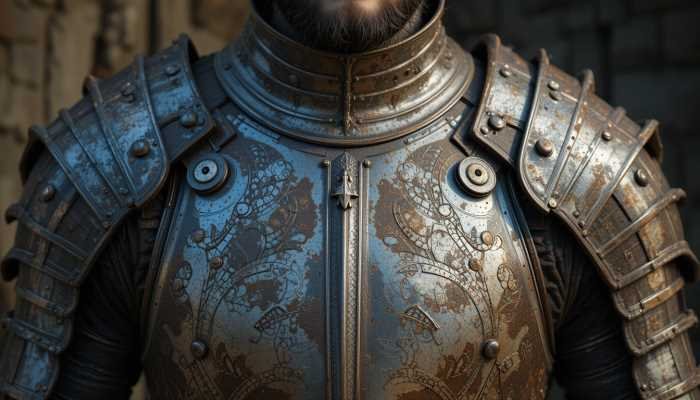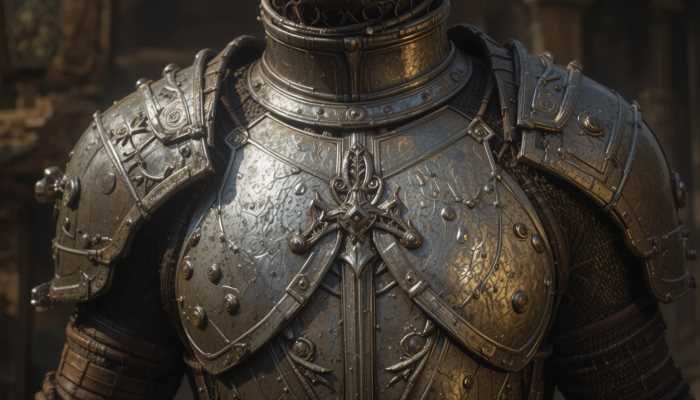Splint Armor: History, Fantasy, and Tabletop Guide

Splint armor is a unique type of body protection created by fastening long, vertical strips of metal (called splints) to the leather or textile backing. With distinctly excellent protective qualities and comparatively easier and cheaper to produce than full plate armor, splint armor was popular throughout the medieval period and remains a staple of historical studies, fantasy literature, and tabletop gaming.
In its original application, splint armor was intended to provide some level of coverage and protect mobility for warriors at a reasonable cost and without the bulk of plate armor. While today’s usage of split armor continues to appear in games such as Dungeons & Dragons and Baldur’s Gate 3, its continued presence as a balance between realism and adaptability is a key portion of its appeal. Thus, from the battlefields of long ago to the imaginative spaces of today, splint armor’s legend is strong and continues.
- What Is Splint Armor?
- The Origins of Splint Armor in History
- Real Splint Armor: Functionality and Construction
- Medieval Splint Armor: Europe’s Overlooked Defense
- Fantasy Splint Armor: Design Meets Imagination
- Splint Armor in Dungeons & Dragons 5e
- Adamantine Splint Armor Mold in D&D
- Splint Armor in Baldur’s Gate 3
- Mithral Splint Armor 5e: Lightweight Power
- Comparing Splint Armor Across Systems
- Modern Recreations and Reenactments
- Design Influence in Pop Culture and Media
- Conclusion: The Timeless Utility of Splint Armor
What Is Splint Armor?
Splint armor is a multi-layered protective system featuring narrow strips of metal (often steel or iron) that are attached vertically along a backing of heavy fabric or leather. Because the splints are align as naturally as possible on the body, especially limb areas, it is enjoyed form flexibility much more than full plate and scale armor, and a better trade off flexibility vs protection than partially armored options.
Many of these open-faced designs allow humidity and sweat to evaporate so parts of the body can cool down in warm conditions, much more than other armor options. You can often repair the splint armor in a just few moments as opposed to full plate armor which requires a repair shop or qualified individual’s tools.
Functionally splint armor gives high resistance to slashes and moderate armor against piercing. The trade off rented in weight/bulk, and deafening noise compared to other lighter options such as leather and mail, and helped protect important limbs but however not limiting movement as wholly as full plate would do. While people may prefer other options, splint is particularly useful for those come online as mid level combatants who may need the mobility of a combatant without the limitations.
The Origins of Splint Armor in History
Splint armor originated in the early medieval period, during and right after the late Roman Empire. Splint armor emerged as an alternative to basic lamellar and scale armor.
Historically, splint armor has typically covered the legs and arms, and are most often observed worn in conjunction with chainmail and/or padded tunics. For mid-tier soldiers or mercenaries who couldn’t afford the high cost of full plate armor, splint armor was a middle-ground solution.
Splint armor, heavy or light, could be and was made of iron splints that were riveted to linen or leather, and thus easy to produce with materials on hand. An armor with splints might be found in Norse, Byzantine, and Eastern European armories, although each regional military tradition adapted the splint style to their specific lance and close combat objectives.
The splint armor’s modular components allowed for innovative configurations and variable regional adaptations. As metallurgy of the time dramatically improved throughout the Middle Ages, splint armor was used instead only occasionally and as a less-than-than complete solution versus a full plate system. However, splint armor remained a viable combat option for significant centuries.
Real Splint Armor: Functionality and Construction
Historically, splint armor was practical, cost-efficient, and somewhat easy to make. Armorers simply cut long thin strips of metal, and placed them vertically over a thick layer of cloth or leather, and then the splints were riveted into place in overlapping rows, allowing limb movement. Splint armor was well suited for arms and legs. When the advent of mail was used to defend the torso, as well as the vital organs, a warrior could gain a fair range of motion with decent protection against slashing and stabbing weapons.
On the field of battle, splint armor had some notable advantages. Splint armor also possessed the advantage of being easier to repair, versus plate and could also recover individual splints to replace damaged ones. The effects of splint armor were to create some weight unbalance and left the exposed joint areas for the worst case scenario. Splint armor saw use primarily with knights in transitional periods, along with well-financed mercenaries, and as the professional infantry equipment of late medieval armies for troop types behind knights. Ultimately, while it was eclipsed by full plate over time, splint armor was overall a well-liked option, for functional durability and modular design.
Medieval Splint Armor: Europe’s Overlooked Defense
During the centuries from the 13th to the 15th, European soldiers tended to utilize splint armor as a compromise between chainmail and fully articulated plate. For soldiers, splint armor protected the limbs and was often 1/2 to 1/5 the cost to manufacture as fully articulated plate armor.

When splint armor was made, it was commonly paired with chainmail hauberks and padded gambesons for entire body protection. These soldiers were less common among the nobility but were represented, to be sure – when soldiers need real protection but cannot afford the more expensive noble armament.
As time went on, armorers really learned how to produce a full suit of plate armor, and splint armor became less common, but splint designs were integral to the development of personal armor in the transition of medieval European armament.
Fantasy Splint Armor: Design Meets Imagination
In fantasy worlds, splint armor takes on a more artistic style and additional features. Typically, it may be depicted or shown with intricate carvings, glowing magic runes, or elements from fantastical materials (e.g. dragonbone, enchanted steel).
The depiction of splint armor in movies, games, and books is also updated with different stylings to focus on visual drama while not sacrificing functionality. The hard vertical lines and visible metal can add drama and composure while it declares extreme protection.
In a fantasy setting, splint armor successfully finds a balance between “realism” and “how to creatively think about armor.” You can visualize splint -armor not only as a war tool, but something that also represents class, nobility, or magical heritage. This helps to keep splint -armor to be iconic in fantasy roleplaying and fantasy literature.
Also Read: Academy Guns: Complete Guide to Firearms at Academy Sports
Splint Armor in Dungeons & Dragons 5e
Splint armor has good protection in Dungeons & Dragons 5e. It gives an Armor Class (AC) of 17, so it’s among the highest AC for medium-access armors. The downside of splint -armor is the strength requirement of 15 to avoid disadvantages, not every player is capable of that. Additionally, splint -armor has the disadvantage for any stealth checks because of its weight.

In terms of cost, the splint armor 5e cost is 200 gold pieces. This puts it just below the best armor, the plate armor, and really is accessible to only medium users. Paladins and clerics are the common users of splint armor, because they get a heavy advantage to their protection without needing to rely on a stealth style English.
There are magical versions too, such as Mithral Splint- Armor, that get rid of the stealth disadvantage, which means it is important for a character that wants to use stealth and still wanting to wear armor. It has advantages versus chain mail, in that there is better defense but that comes with extra cost and weight. Splint -armor also isn’t the most elite choice; plate is still better, splint armor is a unique niche that provides heavy-armored characters that haven’t hit the top-tier skills a method to play with better protection.
Adamantine Splint Armor Mold in D&D
A mold for adamantine splint -armor in Dungeons and Dragons gives players a way to craft armor from one of the rarest materials in the game: adamantine. This is armor that can be found in treasure hoards or as a reward from powerful entities. The mold will provide the recipe for crafting splint -armor that will denote a critical hit as instead a regular hit! This provides a level of survivability beyond anything players usually have access to.
While crafting this armor as a player, players will need to have proficiency with smith’s tools, the adamantine mold, and adamantine! Adamantine can usually be acquired through adamantine veins or adamantine scrap in ominous, trapped dungeons! The DM may even require time and gold to craft the armor, that may add some additional narrative to the armor.
In a campaign focused heavily on crafting and exploration while players will truly find tactical and narrative value in the adamantine splint armor mold. If the players forge it in a dwarven forge, or find it in the estate of a dead blacksmith, the adamantine splint -armor mold turns regular protection into protection of legendary capabilities.
Splint Armor in Baldur’s Gate 3
Splint armor, a top tier heavy armor in Baldur’s Gate 3 and great option for fighters, paladins, and other front line classes, provides a decent AC value of 17 that matches what it would offer in the tabletop version of D&D 5e. Players can collect splint- armor from territories or shop for expensive armor in lands of major settlements or find it as they loot from strong enemies. It has encumbrance and stealth penalty to be aware of, so it will require attention to inventory management.
In Baldur’s Gate 3, splint armor looks really good with its clean lines and texturing that mimics medieval designs. There are also some upgrade iterations of splint- armor that grant magical bonuses, some with different enchantments, or some have unique looks that can allow players to mesh with their character’s lore.
Mithral Splint Armor 5e: Lightweight Power

The Mithral Splint Armor is an uncommon magical item in D&D 5e that has the same AC of 17 and replaces the Stealth-disadvantage of standard splint -armor, making it perfect for those heavy armor steath-based users. Mithral is a lightweight, but still resilient, silvery metal that’s commonly mined in dwarven kingdoms or ancient ruins. Where splint -armor is bulky and nearly unwearable, mithral becomes fluid and flexible, allowing its wearer to use their armor for fighting while not spooking their reconnaissance efforts. As such, it’s a distinctly favorited armor for multiclass users (e.g. the palagon-rogue, or heavy-clerics on low-key missions).
Because mithral armor is considered an uncommon item, there are more possibilities of its availability in a campaign than adamantine, for instance, but it is still a rarity. If the user values durability, flexibility, and overall upgrade, they should consider obtaining this armor!
Comparing Splint Armor Across Systems
Splint armor, traditionally a heavy armor, appears in multiple fantasy and gaming systems each with their own idiosyncracies. Pathfinder has splint -armor with similar stats, but it’s an uncommon armor type. Dungeons and Dragons has splint armor as a relatively inexpensive type of heavy armor. Baldur’s Gate 3 is very much in line its tabletop counterpart, while Skyrim and other Elder Scrolls titles feature various armored clothing similar to splint, but under a different name.
Several variables separate the different splint -armors; mainly, range of movement, price, and disadvantages when attempting to move stealthily in heavy armor. However, the essence of the armor remains the same in all its various incarnations. Splint -armor consists of vertical, intersecting metal bands offering an equal measure of protection in the upper and lower body. Regardless of how diversely splint- armor appears, it is a perfect transitional armor for a character featuring a pixelated version of plate armor for protection, without the full costs of full plat armor.
Modern Recreations and Reenactments
Today, splint armor is being recreated by hobbyists in SCA (Society for Creative Anachronism) events, historical reenacting, and LARPing to some degree. These productions often use modern materials, such as spring steel, aluminum, or hardened leather. Some artists produce historically accurate versions utilizing traditional blacksmithing techniques, riveted joints, and reproducing patterns from documented historical sources. Splint- armor is valued in these groups since it has a gorgeous appearance and provides mechanical utility for mock fighting.
Enthusiasts can obtain armor from armories, or can build their own version at home, utilizing blueprints and tutorials available online by mixing historical content and their own creativity with viable craftsmanship.
Design Influence in Pop Culture and Media
Splint armor is common in fantasy films, video games, comics, and toys because its ribbed, muscular appearance creates visual appeal for characters. The Lord of the Rings films and shows such as The Witcher may have armor designs inspired by splint or possibly based on it. Video games such as Dark Souls, Skyrim, and Dragon Age also use splint-style armor as part of their item collections.
In the toy and action figure arena, toy companies and toy action figures often add splint -armor to their knight or warrior figures because it has a unique, bold, and robust look, which keeps splint relevant in popular fantasy culture.
Conclusion: The Timeless Utility of Splint Armor
Splint armor persists because it fills the gap between form and function across historical and imaginative places. Historically, splint- armor provided effective protection without the cost or weight of plate armor. In fantasy and games, splint- armor is a display of a warrior’s willingness to go to battle but also a way of displaying individuality.
Splint armor is as functional in the real world as it is in terms of imagination and offers a way of bridging modularity and functionality and even iconic vertical ways of plating. Whether within the makerspace of a medieval smithy or a fantasy realm by magical enchantment splint- armor carries its own weight, it is durable, imaginative, and an enduring armor design that represents warriors both real and imagined.




